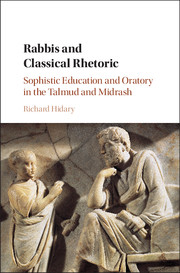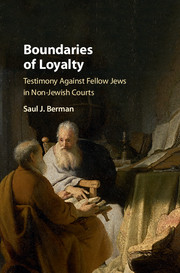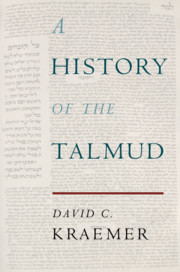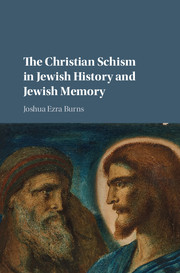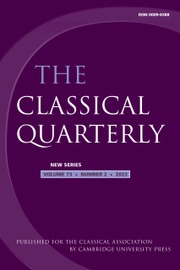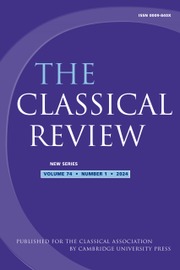Rabbis and Classical Rhetoric
Sophistic Education and Oratory in the Talmud and Midrash
- Author: Richard Hidary, Yeshiva University, New York
- Date Published: December 2017
- availability: In stock
- format: Hardback
- isbn: 9781107177406
Hardback
Other available formats:
Paperback, eBook
Looking for an inspection copy?
This title is not currently available on inspection
-
Training in rhetoric - the art of persuasion - formed the basis of education in the Roman Empire. The classical intellectual world centered around the debate between philosophers, who boasted knowledge of objective reality, and sophists, who could debate both sides of any issue and who attracted large audiences and paying students. The roles of the Talmudic rabbis as public orators, teachers, and jurists, parallel that of Roman orators. Rabbinic literature adopted and adapted various aspects of the classical rhetorical tradition, as is demonstrated in the Talmudic penchant for arguing both sides of hypothetical cases, the midrashic hermeneutical methods, and the structure of synagogue sermons. At the same time, the rabbis also resisted the extreme epistemological relativism of rhetoric as is evident in their restraint on theoretical argumentation, their depiction of rabbinic and divine court procedure, and their commitment to the biblical prophetic tradition. Richard Hidary demonstrates how rabbis succeeded in navigating a novel path between platonic truth and rhetorical relativism.
Read more- Reads rabbinic literature in light of Greco-Roman context and provides the reader with a context in which to understand features of Talmudic structure and argumentation that may seem strange to a modern sensibility
- Examines how the rhetorical tradition was incorporated into an example minority culture, helping readers interested in the Roman Empire to appreciate how minorities in the Greek East experienced the dominant culture
- Covers a range of texts from legal, to exegetical, to homiletic, appealing to a range of readers who may be interested in different genres and a variety of approaches
- Compares ancient views of Greeks and Jews regarding truth and interpretation, making it a useful tool for modern readers who grapple with issues of truth, interpretation, and subjectivity - especially in light of postmodernism - and the book will provide them with historical background to compare ancient and modern approaches
Reviews & endorsements
'In this brilliant and lucid exploration of the impact of classical rhetoric on Talmudic literature, Richard Hidary shows how the ancient Jewish rabbis positioned themselves between Plato and the sophists, between philosophy and rhetoric, between truth and subjectivity. An innovative and nuanced elucidation of rabbinic epistemology and ontology, this volume opens new vistas on the study of ancient Judaism in its late antique Mediterranean context.' Christine Hayes, author of What's Divine about Divine Law: Early Perspectives
See more reviews'Richard Hidary's examination of the nature and origin of the Talmud's unceasing and inimitable dialogue is a carefully wrought and balanced presentation of the case for seeking the origin of the unique character of both the Babylonian Talmud, and its counterpart in Roman Palestine, in the rhetorical structure of the building block of both talmuds: the sugya, which is essentially an essay in dialogue form, made up of a concatenation of arguments and counter-arguments, which, in the case of the Babylonian Talmud, often culminates in a culmination but not a resolution. Building on previous work on the Graeco-Roman sources of the Talmud's structure and nature, Hidary's monograph nevertheless breaks new ground and provides many fresh insights even for those - like myself - who have studied it since childhood.' Yaakov Elman, Herbert S. and Naomi Denenberg Professor of Talmudic Studies, Yeshiva University, New York
'This is a very important book that not too many scholars are capable of writing. Hidary brings wide and deep talmudic erudition together with an impressive command of classical sources to advance our understanding of rabbinic literature in the context of Graeco-Roman learning and culture.' Daniel Boyarin, University of California, Berkeley
'In his erudite and fascinating exposition of the breadth of the presence of Greco-Roman schools of rhetoric in Midrashic and Talmudic texts, Hidary made a wonderful contribution to our understanding of the relationship between the Rabbinic world and Hellenistic culture. In avoiding simplistic forms of parallelism, Hidary's meticulous philological and historical study illuminates brilliantly the deepest questions of revelation, truth and interpretation that were at stake in this momentous cultural encounter.' Moshe Halbertal, New York University
'… a piece of fine scholarship. ' Eric Ottenheijm, Journal for the Study of Judaism
Customer reviews
Not yet reviewed
Be the first to review
Review was not posted due to profanity
×Product details
- Date Published: December 2017
- format: Hardback
- isbn: 9781107177406
- length: 344 pages
- dimensions: 235 x 158 x 22 mm
- weight: 0.62kg
- contains: 2 b/w illus.
- availability: In stock
Table of Contents
Introduction
1. Rabbis as orators: the setting and structure of rabbinic homilies
2. Rabbis as instructors: rhetorical arrangement and reasoning in the Yerushalmi
3. The agonistic Bavli: Greco-Roman rhetoric in Sasanian Persia
4. Progymnasmata and controversiae in rabbinic literature
5. Talmudic topoi: rhetoric and the hermeneutical methods of Midrash
6. The role of lawyers in Roman and rabbinic courts
7. Why are there lawyers in heaven?
Conclusion: rabbinic versus Christian approaches to rhetoric.
Sorry, this resource is locked
Please register or sign in to request access. If you are having problems accessing these resources please email [email protected]
Register Sign in» Proceed
You are now leaving the Cambridge University Press website. Your eBook purchase and download will be completed by our partner www.ebooks.com. Please see the permission section of the www.ebooks.com catalogue page for details of the print & copy limits on our eBooks.
Continue ×Are you sure you want to delete your account?
This cannot be undone.
Thank you for your feedback which will help us improve our service.
If you requested a response, we will make sure to get back to you shortly.
×
